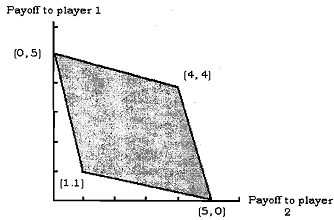Friedmans theorem:
Friedman's theorem (1971) is another milestone in determining the existence of sub-game perfect Nash equilibrium of an infinitely repeated game G (a, 3). But before stating the theorem, we need to know a couple of definitions.
Feasible Payoff: We call the payoffs (x1, x2,.., xn) feasible in the stage game G if they are a convex combination (i.e., a weighted average, where the weights are non-negative and they sum up to one) of the pure-strategy payoffs of G. In the following diagram we present the feasible payoffs of the Prisoners' dilemma game, by the shaded region. The pure strategy payoffs are feasible and they are (1, 1 ), (0, 5), (5, O), (4,4). One can check that any payoff allocation inside the shaded region can be achieved as a weighted average of the pure strategy payoffs.

Average payoff: Till now we defined players' payoff in an infinitely repeated game to be the present value of the infinite sequence of stage game payoff. But it is more convenient to express the present value in terms of the average payoff from the same infinite sequence of stage game payoffs. The average payoff of an infinitely repeated game is the payoff that would have to be received in every stage so as to yield the same present value. Let d be the discount factor. Suppose the infinite sequence of payoffs  has the present value V. If the payoff rwere ,received in every stage, the present value would be
has the present value V. If the payoff rwere ,received in every stage, the present value would be . For r to be the average payoff from the infinite sequence,
. For r to be the average payoff from the infinite sequence, with discount factor d, the two present values must be equal, which gives n = V.(1 - d ). That is, the average payoff is (1 - d )times the present value. Given the discount factor d, the average payoff of the infinite sequence of
with discount factor d, the two present values must be equal, which gives n = V.(1 - d ). That is, the average payoff is (1 - d )times the present value. Given the discount factor d, the average payoff of the infinite sequence of

Friedman's Theorem: Let G be a finite static game of complete information. Let (e1, e2, e3, .....en) denote the payoff from a Nash equilibrium of G, and let (x1, x2, x3, ..... xn ) denote any other payoffs from G. If xi > ei for every player I and if δ is sufficiently close to one, then there exists a sub-game perfect Nash equilibrium of the infinitely repeated game  that achieves (x1, x2, x3, ..... xn) as the average payoff.
that achieves (x1, x2, x3, ..... xn) as the average payoff.

Friedman's theorem ensures that any point in the dotted area in the above diagram can be achieved as the average payoff in a sub-game perfect Nash equilibrium in a repeated game, provided that the discount factor is sufficiently close to one.